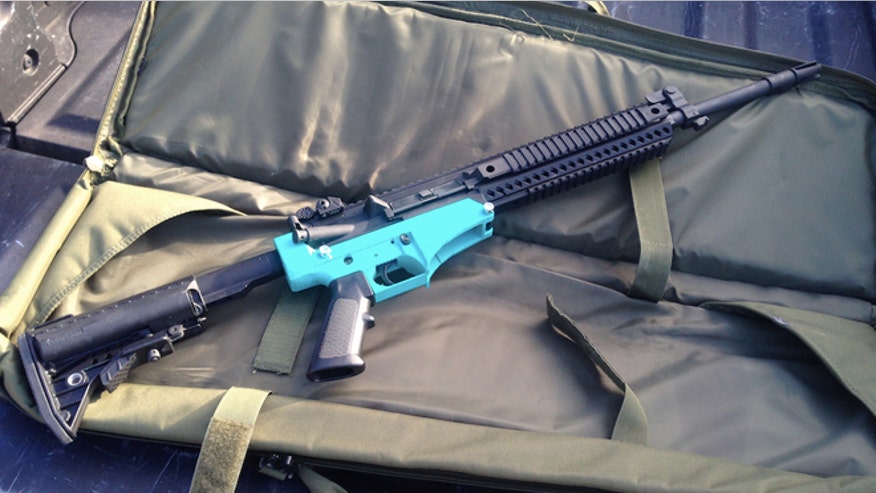 |
| Colt CM901 Assault Rifle with a blue 3D printed lower reciever |
This blog is dedicated to my first year seminar for engineering design and will consist of several engineering topics including projects, current products, ideas, and more interesting things in the present world of engineering!
Monday, March 30, 2015
The Road to 3D Printed Guns
Future Firefighters
 |
| A "Robot on reins" in a smokey cave |
However, the creating team did not release too many specific details of the robot yet causing several question to arise, such as:
- How much do these robots cost to make?
- Will these robots become a common thing for every firehouse?
- What is the melting point of these robots or what is the max heat that they can withstand?
- How much do these robots weigh?
- How long would they take to set up on the scene of a fire?
Original Article:
http://www.sciencedaily.com/releases/2015/03/150325082029.htm
Monday, March 2, 2015
The UniMoto
So throughout our First Year Seminar class, we have came across topics such as the Segway that was created by Dean Kamen along with Open-Sourced inventions such as the 3D printers mentioned in one of my recent posts. I am sure that almost everyone reading this also knows what a Uni-cycle is as well. The thing is that the Segway was not as big of a seller as Dean Kamen thought it would be. However, the Segway was not a complete bust as the technology that was incorporated into it is still being incorporated into new inventions. One relatively new invention that this technology has been incorporated into is called the SoloWheel.
 As I was walking back home after one of my classes, I noticed a kid riding one of these "contraptions?" and decided to look more into what it actually was when I got back. So to put it in a nutshell, the SoloWheel is a single wheeled Segway without the handles or can be thought of as a motorized, self-balancing Uni-Cycle without a seat or pedals. But sadly this invention runs for around $1800 putting it out of reach for many potential users. In response to this, in Decemeber 2011, the "UniMoto" open source project was started to try to make a cheaper version of the SoloWheel. The goal was to have a finished prototype for its release by March, 2012 that sold for around $800. I have ever only seen that one SoloWheel/UniMoto (do not know which it was) so I am guessing that they were not very popular either, but none-the-less they are still pretty cool little things and would most likely be fun to have.
As I was walking back home after one of my classes, I noticed a kid riding one of these "contraptions?" and decided to look more into what it actually was when I got back. So to put it in a nutshell, the SoloWheel is a single wheeled Segway without the handles or can be thought of as a motorized, self-balancing Uni-Cycle without a seat or pedals. But sadly this invention runs for around $1800 putting it out of reach for many potential users. In response to this, in Decemeber 2011, the "UniMoto" open source project was started to try to make a cheaper version of the SoloWheel. The goal was to have a finished prototype for its release by March, 2012 that sold for around $800. I have ever only seen that one SoloWheel/UniMoto (do not know which it was) so I am guessing that they were not very popular either, but none-the-less they are still pretty cool little things and would most likely be fun to have.
 I have not found any recent updates about the UniMoto but the original plans consisted of a frame that was made out of Lexan (some sort of plastic maybe?) that compacted the wheel, batteries, and motor together. The plans consisted of having four Lithium-Polymer batteries that would be able to power the UniMoto for about an hour and for speeds up to fifteen miles per hour. The foot stands would also be able to fold up making the UniMoto more portable. I said before, I did not come across anything else about this Open Source "UniMoto" project but there has been several other "Motorized Unicycles" / "Single Wheeled Segways" (whichever you prefer to call them) that have been made since this idea was originally started.
I have not found any recent updates about the UniMoto but the original plans consisted of a frame that was made out of Lexan (some sort of plastic maybe?) that compacted the wheel, batteries, and motor together. The plans consisted of having four Lithium-Polymer batteries that would be able to power the UniMoto for about an hour and for speeds up to fifteen miles per hour. The foot stands would also be able to fold up making the UniMoto more portable. I said before, I did not come across anything else about this Open Source "UniMoto" project but there has been several other "Motorized Unicycles" / "Single Wheeled Segways" (whichever you prefer to call them) that have been made since this idea was originally started.
Link to UniMoto Video
https://www.youtube.com/watch?v=HZhkoLbFjT8
Subscribe to:
Comments (Atom)